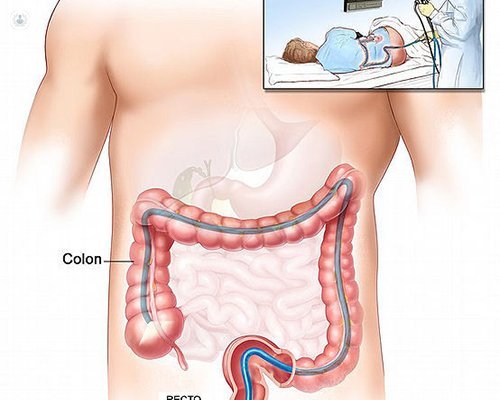Gastroscopy and colonoscopy to explore the digestive system
Written in association with:The exploration of the Digestive System is very important to detect any anomaly that may be affecting the daily life of the patient. The doctor. Matas, an expert in Digestive System , talks about the main diagnostic tests that analyze the interior of the digestive tract.
Digestive endoscopy is the main diagnostic test for the Digestive System. It consists of analyzing the interior of the digestive tract by direct visualization of it through a television monitor, which picks up the image of a chamber located at the tip of the endoscope, a flexible tube that is inserted through the mouth in the case of the gastroscopy or by the anus if a colonoscopy is performed. These tubes have several channels through which air can be breathed in or aspirated, and tweezers can be taken to allow biopsy samples to be studied to study a specific tissue, as well as removal of polyps and other excretory lesions, both of which are completely painless.
Indications of endoscopy
Endoscopy is indicated as a complementary test in the diagnosis of anomalies or problems of the digestive tract, such as tumors, malformations, hemorrhages, polyps, gastroesophageal reflux, celiac disease, problems in food absorption, poor digestion of food, chronic diarrhea or suspected gastric or duodenal ulcer, among others.
In addition, endoscopy allows "surgical interventions" inside the digestive tract, biopsies of tissues, extraction of foreign bodies or sutures, reducing the possibility of complications and avoiding the need for hospitalization.
Previous diet for gastroscopy and colonoscopy
To perform a gastroscopy , also known as oral panendoscopy, to visualize the esophagus, stomach and duodenum principle, it is only necessary to go fasting for 8 hours, enough so that that part of the digestive tract is clean of food and can be seen clearly . Before starting gastroscopy, you can reduce vomiting reflexes by applying a local anesthetic, which is usually given as a lidocaine spray in the throat.
Colonoscopy requires more previous preparation. In addition to fasting, as the most perfect cleaning of the colon or large intestine is necessary, the patient must carry a low-residue diet for a few days prior to the examination, as well as take an intestinal evacuation solution. Sometimes it is even necessary to apply a cleaning enema if the stools are not clean enough.

Duration of Gastroscopy and Colonoscopy
Gastroscopy is an exploration of an average duration of about 5-15 minutes, although when it is required to take biopsies or to perform some other intervention like removing a polyp can be more durable, about 10-30 minutes.
The total colonoscopy is a scan of the entire colon, from the anus to the cecum or appendicular area, and sometimes it is sometimes necessary to explore the last course of the small intestine called the terminal ileum. Therefore, it may require a very variable time, from 15 to 60 minutes depending on the characteristics of the colon and the experience of the specialist in the digestive system that performs the examination.
Is gastroscopy and colonoscopy painful?
Gastroscopy is generally well accepted once performed, although it has a certain reputation of being very annoying. The local throat anesthesia is usually enough to make it quite bearable, since it is not a painful exploration and presents the annoyance of the passage of an endoscope through the throat, which is an area with many reflexes. Since the path that follows is the same as food, the airway is free and you can breathe freely through your nose, mouth, or both. The gastroscope has a length of about one meter and the colonoscope 1.5 - 1.8 meters. There are also shorter colonoscopes, about 60 cms., Which are called sigmoidoscopes, but are hardly used today.
Total colonoscopy , unlike gastroscopy, is an annoying and painful examination due to the insufflation of air and the traction produced by the endoscope. For this reason, in recent years many Digestive Services have adopted sedation or soft general anesthesia as a formula to avoid discomfort.
Currently the practice of sedation in endoscopies is the usual, except in exceptions indicated by the doctor who prescribes the test or at the patient's request.
Risks after Gastroscopy or Colonoscopy
Both gastroscopy and colonoscopy are very safe examinations in the hands of good specialists, and there is only a risk of complications (usually perforations) in very exceptional cases with inexperienced professionals.
After completing the explorations, it is not necessary to follow any recommendation, except for the one stipulated by the sedation and in the case of any therapeutic intervention, taking into account each patient.
As for the medical material, once the endoscopic examination is completed, the endoscopes follow an intense process of cleaning and sterilization in order to avoid the transmission of diseases.


